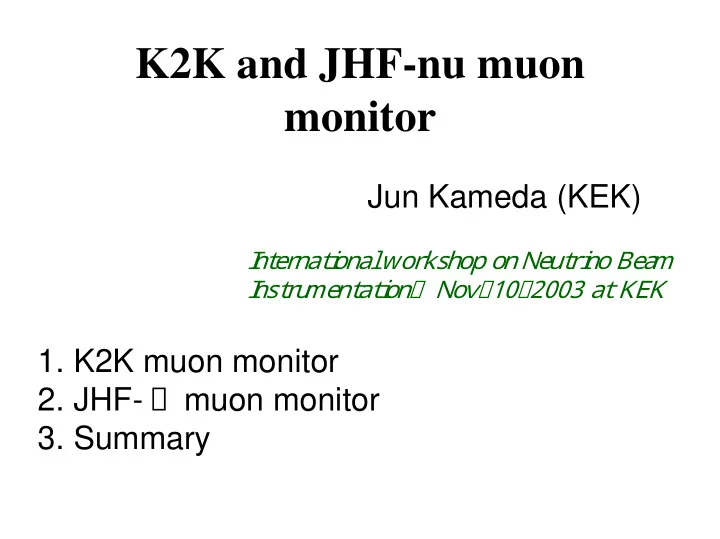

K2K and JHF-nu muon monitor Jun Kameda (KEK) I n t e r n a t i o n a l w o r k s h o p o n N e u t r i n o B e a m I n s t r u m e n t a t i o n , N o v . 1 0 , 2 0 0 3 a t K E K 1. K2K muon monitor 2. JHF- ν muon monitor 3. Summary
1. Muon monitor in K2K experiment 200 m 3.5m Silicon detector Ion chamber ν π μ proton π Target � Purpose of the muon monitor: • Guaranteeing the beam direction spill by spill. • We also use the muon monitor for beam tuning. (Beam should be aimed to Super-K within 1 mrad in K2K). • Indirect monitor of the horn magnet field and targeting .
1-1. K2K Muon Monitor Ion Chamber 2 m x 2 m area is covered. 32 ch. ( Y axis ) 36 ch. ( X axis ) Two different type Silicon pad detectors detectors give a redundant monitoring 1cm x 2cm PIN diode (x 17) 3.45cmx3.45cm PIN diode (x 9 )
1-2. Signal of the muon monitor Ion Chamber We can clearly see the direction of the beam. Silicon Detector
1-3. Stability of the muon direction Super-K +- 1 mrad Super-K +- 1 mrad Muon center is stable within ± 1 mrad.
2. Muon monitors for JHF- ν • Monitor the beam direction spill by spill. Purpose: • Beam direction will be tuned using muon monitor, so muon monitor is a key detector. • Indirect monitor of the proton targeting position and the horn magnet status. Requirements: 1. Stability Dead time of the muon monitors directly makes the dead time of the experiment. (This is from our experience of K2K experiment.) 2. Good sensitivity for direction, yield & shape 3. Redundancy
2-1. Position of the muon monitor Muon monitor will be placed behind the beam dump. If the distance D become shorter, � Lower muon threshold, and the sensitivity to the direction, the horn magnet & proton targeting become better. � But, Higher radiation level We estimate a good D(m) by a Monte Carlo simulation.
2-2. P μ distribution before the beam dump � Muon yield has a good sensitivity for the Horn Magnet field. � Over ~ 15 GeV/c muons don’t have the sensitivity to horn magnet field.
2-3. Muon profile after propagating the beam dump (projected to X axis ) Beam dump ( solid Fe is assumed ) μ 540 cm 300 cm D (cm) We can well see the center of the muon beam with a few GeV/c thresholds. Shape become wider as threshold increases. : All charged particles : muon+
2-3. Muon profile after propagating the beam dump (projected to Y axis ) Beam dump ( solid Fe is assumed ) μ 540 cm 300 cm : All charged particles : muon+
2-4. Sensitivity for the targeting position Targeting position changes → Muon center moves. � We can see the change of the targeting condition by muon. proton beam target 3.0 cm horn system works as a Lens system
2-4. Proton beam position vs Muon center ∆ (muon center) ≈ 100 ∆ (proton beam position) � Same order as K2K measured value. � Sensitivity is lower with higher momentum threshold (~ 7,8 GeV/c).
2-5. Particle flux at each depth Muon flux: 6x10 7 muons /cm 2 /spill = 2.4x10 14 muons/cm 2 /year at 5 GeV/c threshold (=365 cm thick Fe) (same order as LHC) electron flux: 1.2x10 7 particle/cm 2 /spill Simulation thresholds are set to: proton, neutron : 2 MeV γ ,e + ,e - : 100 keV 5 GeV/c threshold
2-6. Requirement for muon monitor in JHF- ν 1. Size: Muon beam has about 1.0 m width (@ 5 GeV/c threshold). � ~3 m x 3 m should be covered. 2. Muon momentum Threshold: Muon center is clearly seen with a few GeV/c threshold. Around 3-5 GeV/c threshold, no big difference of the sensitivity of the proton beam position & magnetic field. 3. Radiation hardness: It should survive much longer than 1 year under 2.4x10 14 muon/cm 2 /year condition at 5 GeV/c threshold.
2-7. Possible detector types : • Established technology. Ion Chamber It can work in this radiation level. • Less radiation hard than diamond Silicon detector detector, but a possible choice. • LHC ATLAS uses Si detector in the same order radiation level. • Radiation hard than Si detector. Diamond detector • We have no experiences, and we’ll study in K2K beam. • Directly measure muons as electric current. CT ? • Radiation hardness is expected to be good, but work as a muon monitor ?
Summary 1. K2K muon monitor: muon monitor for K2K is working well, and the beam direction is stable and aimed to Super-K within 1mrad. 2. JHF- ν muon monitor: Requirement for the muon monitor is estimated by Monte Carlo study: • 3 to ~5 GeV/c threshold give a good sensitivity for proton beam position & horn magnet status. • 6x10 7 muon/cm 2 /spill and 1.2x10 7 electrons/cm 2 /spill are expected at 5GeV/c threshold. (We should check with lower simulation thresholds, especially for neutrons.)
Plan • We’ll carry out beam tests using K2K beam (until 2005) � Radiation damage test of Si detector � R&D of the diamond detector • We’ll start design of the Ion Chamber.
Recommend
More recommend